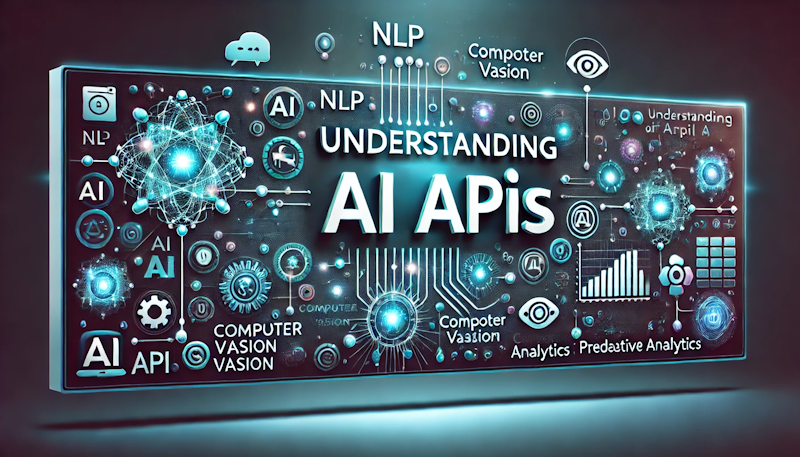Understanding AI APIs with APIpie.ai

In today's rapidly advancing technological landscape, Artificial Intelligence (AI) is no longer a futuristic concept—it's a present reality transforming industries across the globe. From enhancing customer experiences to optimizing operations, AI's potential is immense. But how do businesses and developers tap into this potential without reinventing the wheel? The answer lies in AI APIs, especially those powered by Generative AI.
What is an AI API?
An AI API (Application Programming Interface) is a set of protocols and tools that allows developers to integrate AI functionalities into their applications seamlessly. Think of it as a bridge connecting your application to powerful AI services developed by experts. Instead of building complex AI models from scratch (a process that can be time-consuming and resource-intensive) you can leverage AI APIs to access these capabilities instantly.
AI APIs enable applications to perform tasks such as:
- Natural Language Processing (NLP): Understanding and generating human language.
- Computer Vision: Recognizing and interpreting visual data from images and videos.
- Speech Recognition: Converting spoken words into text.
- Predictive Analytics: Analyzing data to forecast future trends.
- Generative AI: Creating new content like text, images, or music based on learned patterns.
History and Evolution of AI APIs
The journey of AI APIs began with the rise of cloud computing and the need for scalable AI solutions. Initially, AI capabilities were confined to research labs and tech giants due to high computational requirements. However, as cloud services evolved, so did the accessibility of AI.
- Early 2000s: Basic web APIs emerged, allowing for data retrieval and simple interactions.
- Mid-2010s: Advancements in machine learning and deep learning led to more sophisticated AI models.
- Late 2010s to Present: The advent of Generative AI models like GPT-3 revolutionized the field, enabling APIs to offer advanced functionalities like natural language generation and image synthesis.
Key Features of AI APIs
1. Generative Capabilities
Modern AI APIs, especially those leveraging Generative AI, can create new content based on input data. This includes generating human-like text, creating realistic images, and composing music.
2. Ease of Integration
AI APIs come with comprehensive documentation and support, making it straightforward for developers to incorporate AI features into their applications using familiar programming languages.
3. Scalability
Designed to handle varying workloads, AI APIs ensure consistent performance regardless of user demand, allowing your application to grow without bottlenecks.
4. Cost-Effectiveness
By utilizing AI APIs, businesses save on the significant costs associated with developing and maintaining AI models and the necessary infrastructure.
5. Security and Compliance
Reputable AI API providers prioritize data security, offering encryption and compliance with global standards to protect sensitive information.
Common Use Cases for AI APIs
1. Content Creation with Generative AI
Businesses use Generative AI APIs to automate content creation, such as writing articles, generating product descriptions, or creating marketing materials.
2. Customer Service Automation
AI-powered chatbots and virtual assistants enhance customer engagement by providing instant support and personalized interactions, often using Generative AI to produce human-like responses.
3. Image and Video Generation
Generative AI APIs can create realistic images or modify existing ones, aiding in design, entertainment, and advertising industries.
4. Speech and Language Services
Transcription services convert audio to text, while translation APIs break down language barriers, enabling global communication.
5. Personalized Recommendations
E-commerce platforms and content providers use AI APIs to analyze user behavior and preferences, delivering tailored product or content suggestions.
Comparing AI APIs with Other APIs
While all APIs serve as intermediaries between different software applications, AI APIs distinguish themselves through their ability to perform complex tasks that mimic human intelligence, especially in generating new content.
- Functionality: Traditional APIs handle data exchange and basic operations, whereas AI APIs perform advanced computations like pattern recognition and content generation.
- Complexity: AI APIs often handle unstructured data (like images and natural language), unlike standard APIs that deal with structured data.
- Learning Capabilities: AI APIs can improve over time through machine learning, offering enhanced performance with increased usage.
Introducing APIpie.ai's AI API Solutions
At APIpie.ai, our mission is to make AI accessible to businesses of all sizes. We offer a comprehensive suite of AI APIs, including Generative AI capabilities, designed to empower your applications with cutting-edge intelligence.
Why Choose APIpie.ai?
- Generative AI Services: Leverage our advanced Generative AI APIs to create content, generate images, or synthesize speech.
- Comprehensive AI Offerings: From NLP and computer vision to advanced analytics, we cover all your AI needs.
- Developer-Friendly: Our APIs are easy to integrate, with extensive documentation and sample code.
- Top-Notch Security: We adhere to the highest security standards to protect your data.
- Exceptional Support: Our dedicated team is here to assist you every step of the way.
Get Started with APIpie.ai Today!
Imagine transforming your application with AI-powered features in just a few lines of code. With APIpie.ai, this vision becomes a reality.
👉 Ready to unlock the power of Generative AI? Visit APIpie.ai
Join a community of innovators revolutionizing their industries with AI. Let's shape the future together.
